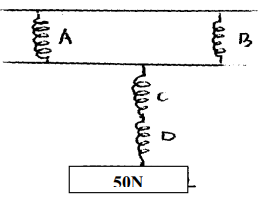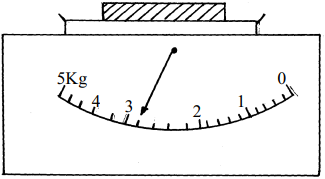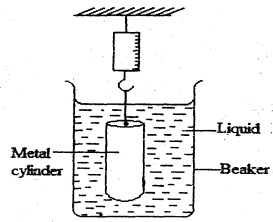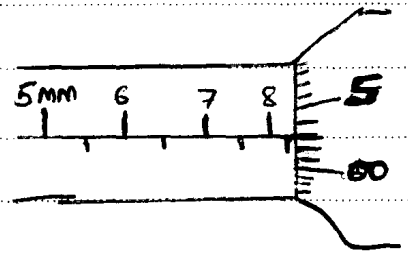Questions
- A ball bearing of mass 0.0015 kg is held between the anvil and spindle of a micrometer screw gauge. The reading on the gauge when the jaws are closed without anything in between is 0.11mm. Use this information and the position of the scale in the figure below to answer the questions (a) and (b) below:
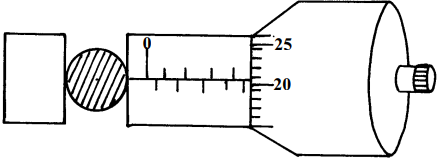
- What is the diameter of the ball bearing?
- Find the density of the ball bearing giving your answer correct to three significant
-
The springs A, B, C and D are identical and each extends by 2cm, when a force of 6N is suspended on the system. Determine the extension of the system - Water in a dam falls through a height 24.5m. If we assume that there are no energy losses, calculate the new temperature of the water as it strikes the lower end, given that its initial temperature at the top of the dam is 18.9°C
- Lycopodium powder is lightly sprinkled on a clean water surface in a large tray. A red hot needle is plunged at the centre of the water surface. State and explain the observation
- A micrometer screw gauge has a negative zero error of 0.06mm. Show on a micrometer screw gauge, including the essential parts only a reading of 5.99mm
- The data below was obtained in an experiment to estimate the diameter of an oil molecule:-
- Level of oil in burette= 26cm3
- Level of oil in burettes after adding 50drops of oil=25.2cm3
- Diameter of oil patch= 7cm- Determine the volume of one drop of oil
- Calculate the thickness of a molecule
- State any two assumptions made in this experiment
- In the experiment, lycopodium powder is used on the water surface. What is the role of the lycopodium powder?
- A molecule of a liquid occupies a space about 1.5 x 10-9m high and about 0.6 x 10-9m in thickness and breadth. Calculate the number of molecules in a litre of the liquid
- The data below was obtained in an experiment to estimate the diameter of an oil molecule:-
- The vernier calipers shown below have a zero error of -0.06 cm
State the actual reading on the instrument. - A micrometer screw gauge with zero error of -0.01mm is used to determine the diameter of a marble whose diameter is 2.32mm.
- State the reading taken when the cylinder is grasped by the jaws
- In the space below, sketch the scale that gives the reading in (a) above if it has a pitch
- The figure below shows an object of volume 300cm3 placed on the pan of a beam balance.
The pointer was initially at the zero mark
Determine the density of the object in Kgm-3 - The figure below shows marble of mass 2.0g placed between the jaws of Vernier calipers. The magnified section is also shown. The reading of the gauge when the jaws were fully closed without the marble was 0.01cm. Use this information and the figure to answer questions a and b.
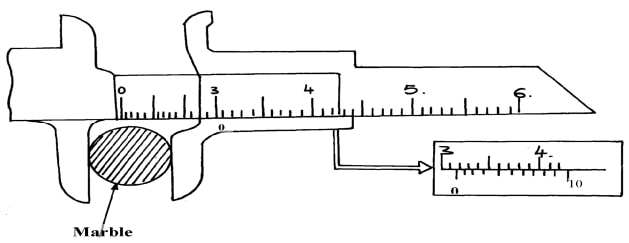
- What is the diameter of the marble?
- Determine the density of the marble give your answer to three significant figure (assume that the marble is spherical)
- Three identical springs A, B and C of negligible weight are arranged as shown below;
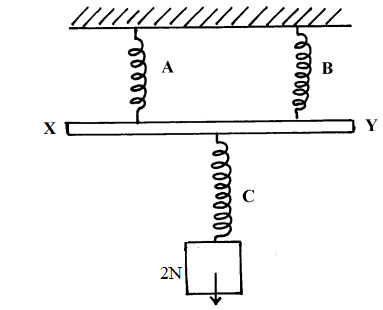
If C stretches by 3cm, and bar XY is assumed to be weightless, determine the extension in A - When a drop of olive oil of radius 1.36mm is placed on the surface of water, it spreads out to form a circular film of diameter 40cm. Calculate;
- The volume of the olive oil drop in m3 (Take π= 22/7)
- Using the value of (a) above, estimate the thickness of the film.
- Explain why lycopodium powder is sprinkled on the surface of water before the oil is dropped on it.
- State two assumptions made when finding the thickness of the film formed.
- Figure (a) below shows vernier calipers with the jaws completely closed while (b) shows the same vernier calipers in use

Determine the actual diameter of the coin - Give the reading on the micrometer screw gauge if it has a positive zero error of 0.01mm
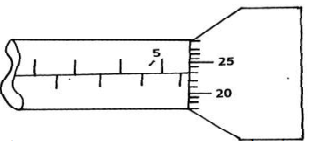
- Draw a sketch of a micrometer screw gauge showing a reading of 8.53mm.
- The figure below shows a micrometer screw gauge being used to measure the diameter of a rod.

The thimble scale has 50 divisions - The figure below shows a measuring cylinder containing some water.
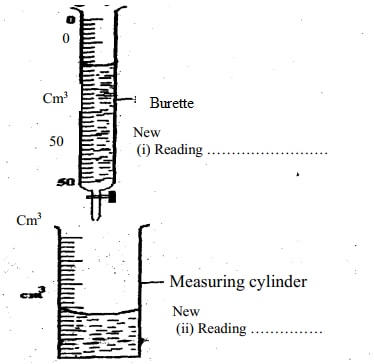
Another 10cm3 of water was in to the cylinder from a burette delivering volumes from 0 cm3 to 50 cm. Record in the spaces provided the new reading indicated on each vessel. - Sketch a vernier calipers scale reading 3.41 cm.
- In an experiment to determine a certain length ‘L’ in a pendulum experiment the following results were obtained:
The up thrust was calculated from the spring balance and it was found to be 0.5N when the cylinder was fully submerged. Determine:- Volume of the metal cylinder.
- Mass of the liquid displaced by the cylinder.
- Density of the liquid
- The figure below shows a scale of part of venier caliper
State the correct reading of the scale if the instrument has a zero error of -0.02cm
Answers
-
- Exact diameter reading – 0.11
- Find the density of the ball bearing giving your answer correct to three significant figures

ρ= m/v
- Determine the extension of the system
6N purchase 2cm extension
50N = 2 × 50 = 16.667 cm
6
Total extension = 16.667 × 2 + 16.667/2
33.33
+8.33
41.66 cm - Take specific heat capacity of water = 4200Jkg-1K-1
mhg = mCΔθ
24.5 × 10= 4200 J/kgK × (θ − 18.9)
24.5 = θ − 18.9
420
θ= 18.95830c - The powder around the hot needle moves away.
Reason- The high temperature of the needle lowers the surface tension of the water around it.
- High surface tension on the sided pits the powder away
- -ve error is added 5.99 + 0.06 = 6.05 mm

-
-
- Volume of one drop = 26.00 – 25.2
50
= 0.8 = 0.016cm3
50 - Thickness of oil molecule = vol. of drop
Area of drop
= 0.016
3.142 x 3.5 x 3.5
= 4.15 x 10-4 cm - – The patch is even
- Oil drop forms a monolayer - – To show the circular patch formed by the oil drop
- Volume of one drop = 26.00 – 25.2
- Vol. of molecule = 1.5 x 10-9 x 0.6 x 10-9 x 0.6 x 10-9
= 0.54 x 10-27 = 5.4 x 10-28 m3
1 litre = 1000cm3
= 1.0 x 10-3 m3
No. of molecules in 1litre = 1.0 x 10-3
5.4 x 10-28
= 0.18515 x 1025
= 1.8519 x 1024 molecules
-
- Actual reading = 3.21 + 0.06; = 3.27cm;
-
- Reading = actual reading = zero error
= 2.32 mm + -0.01
= 2.31 mm (1mk) -
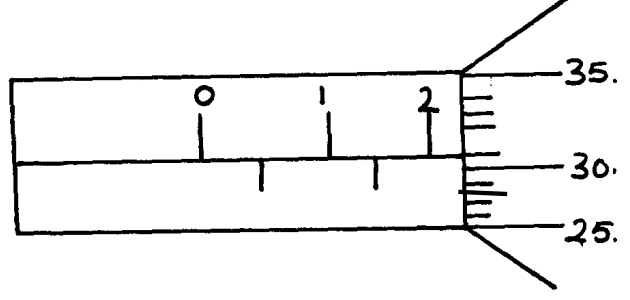
- Reading = actual reading = zero error
- Reading, mass = 2.75Kg ✓ 1
Density = mass/volume = 2.75Kg/3 x 10-4m3 ✓ 1
= 9.167 x 103 Kg/m3✓1
= 9167 Kg/m3 -
- Main scale reading = 3.1cm = 3.1cm
Vernier scale reading = (4x 0.01) = 0.04cm
Diameter f the marble = 3.13 x 10-2m - Volume of the marble = 4/3πr3
= 4 x 3.14 x 1.565 x 1.565 x 1.565 x 10-6
= 10.0476 x 10-6 m3
Mass of the marble = 2.0 x 10-3kg
Density of the disc = mass/volume
= 2.0 x 10-3
16.0476 x 10-6
= 0.1246 x 103
= 12.46 x 102 Kg/m3
- Main scale reading = 3.1cm = 3.1cm
- ½ X 3 ✓ = 1.5cm ✓ 1
-
- Volume of drop = 4/3r3
V = 4/3 × 22/7 × (1.36/1000)3 ✓ 1
= 1.054 × 108 m3 - 4/3r3 = R2t ✓1
t= 4/3 ×(1.36 × 10-3)3
(4.0 × 10-1)2 ✓1
t = 4/3 × 1.363 × 10-9
4.02 × 10-2
= 0.2096 × 10-7
= 2.096 × 10-8 m ✓ - Lycopodium powder makes the film outline clearly visible 1 1 Mk
- - The film/ patch is a perfect circle
- The film is a monolayer
- There is no space between the molecules An
- Volume of drop = 4/3r3
- Zero error + 0.04
Reading diameter = 0.93 – 0.04 - Main scale = 5.5mm
Head scale coincidence = 23/100 mm
Reading = 5.50
- 0.23
5.73mm
Actual reading = 5.73mm – 0.01mm = 5.72mm -
award 1m for the correct diagram
showing the correct reading. ✓1
No mark if the student uses disks on the thimble scale. - Main scale = 6.50 mm
Thimble scale = 0.34 mm
Micrometer reading = 6.84 mm
Join our whatsapp group for latest updates
Tap Here to Download for 50/-
Get on WhatsApp for 50/-
Download Measurement II Questions and Answers - Physics Form 2 Topical Revision.
Tap Here to Download for 50/-
Get on WhatsApp for 50/-
Why download?
- ✔ To read offline at any time.
- ✔ To Print at your convenience
- ✔ Share Easily with Friends / Students

